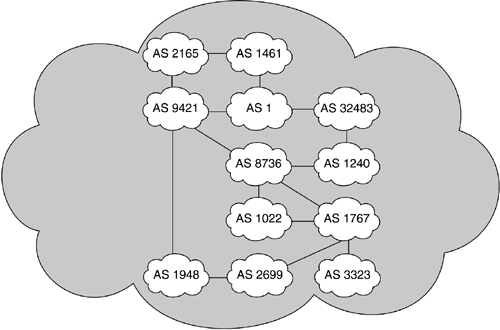Appendix D. Border Gateway Protocol, Version 4 (BGP4)
This appendix covers the following topics:
BGP Multihoming
IBGP Versus EBGP
Common BGP Implementation
BGP Attributes
BGP Route Selection
BGP Peering
BGP Route Reflectors
BGP Confederations
BGP Administrative Distances
BGP Timers
The Border Gateway Protocol (BGP) is used to exchange routing information between Internet Service Provider (ISP) networks, and between ISP networks and customer networks. BGP also can be used as a routing protocol for large-scale enterprise networks. BGP often is the routing protocol used to exchange information between two or more autonomous networks.
NOTEEvery network sharing a common network administration and common routing policies is referred to as an autonomous network. |
An interior gateway routing protocol such as RIP or OSPF is often used within a customer's autonomous network. BGP is used when exchanging network routing information between ISPs or an ISP and its customers.
BGP is a robust and scalable routing protocol and the most widely used routing protocol for the Internet, with over 90,000 BGP routing table entries currently maintained in Internet Service Provider networks. BGP provides scalability by using well-defined route parameters, called attributes, providing for a stable routing environment and sophisticated routing behaviors.
BGP supports Classless Interdomain Routing (CIDR). CIDR reduces the size of the Internet routing tables. For example, suppose that an ISP owns the IP address block 195.10.x.x from the traditional Class C address space. This block consists of 256 Class C address blocks, 195.10.0.x 195.10.255.x. Presume this ISP assigns a Class C block to each of its customers. Without CIDR, the ISP would advertise 256 (Class C) address blocks to its BGP peers. With CIDR, BGP can supernet (aggregate or summarize) the address space and advertise one block, 195.10.x.x.
BGP neighbors exchange full routing information when the TCP connection between neighbors is first established. When changes to the routing table are detected, the BGP routers send to their neighbors only those routes that have changed. Unlike some other routing protocols, such as OSPF or RIP, BGP routers do not send periodic routing updates, advertising only the optimal path to a destination network.
BGP was developed in June 1989 and was published as RFC 1105. BGP was born out of the requirement to move away from a backbone-centered tree-topology and into a more distributed-backbone, autonomous-system based topology.
BGP is an exterior gateway protocol (EGP) and is used to pass routing information between autonomous systems (ASes). BGP is still a routing protocol and, like other routing protocols, BGP passes routing information and uses a metrics for route determination. BGP advertises which networks can be reached and can act in either an interior (IBGP) or exterior (EBGP) mode. IBGP or EBGP configurations mean that BGP can be configured to advertise networks within an AS (Autonomous System) or between different ASes. The key to BGP operation is in the configuration of which networks to advertise and whether they are directly connected.
NOTEBGP uses TCP (port 179) to communicate with other routers. If a BGP router is in operation behind a network firewall, the firewall must be configured to allow TCP port 179 traffic to pass through; otherwise, BGP will not be able to operate. |
The primary purpose of BGP4 is to exchange network reachability information with other BGP autonomous systems. Figure D-1 illustrates how the Internet is constructed with multiple BGP autonomous systems.
Figure D-1. Connectivity Example with Random ASNs

BGP is classified as a path-vector routing protocol. Path vector protocols are similar to distance vector routing protocols. The primary difference between path and distance vector routing protocols lies in that distance vector routing protocols use hop count to calculate the best path to a destination whereas path vector routing protocols advertise the reachable destinations to its neighbors. The border router (BR) advertises these destinations, as well as the attributes of the path to the destination. These path vector attributes include the number of hops and the administrative distance of each hop. Interior (IBGP-based) learned routes are given more "weight," or preference, than those learned from an Exterior BGP (EBGP) advertisement.
EAN: 2147483647
Pages: 269